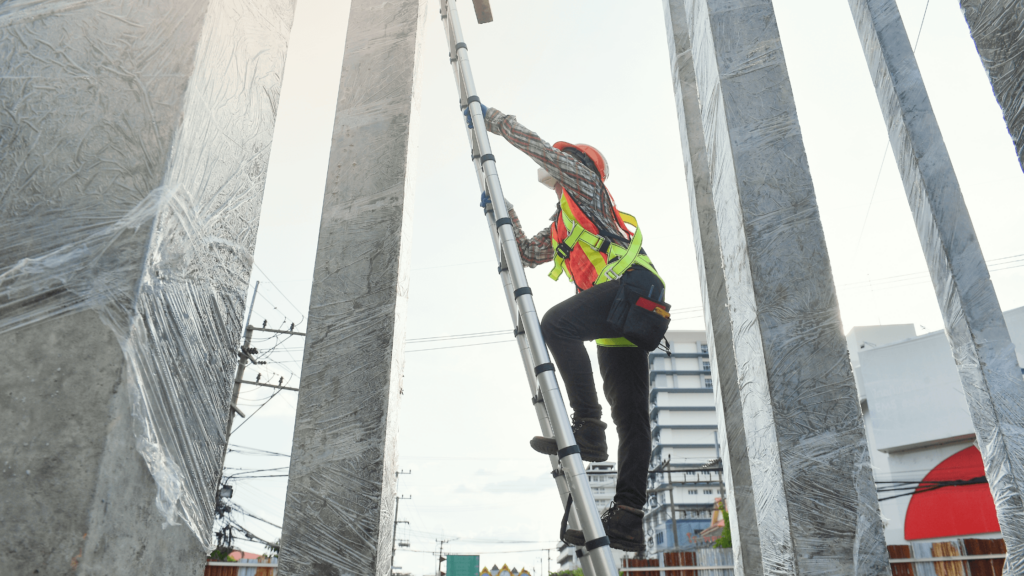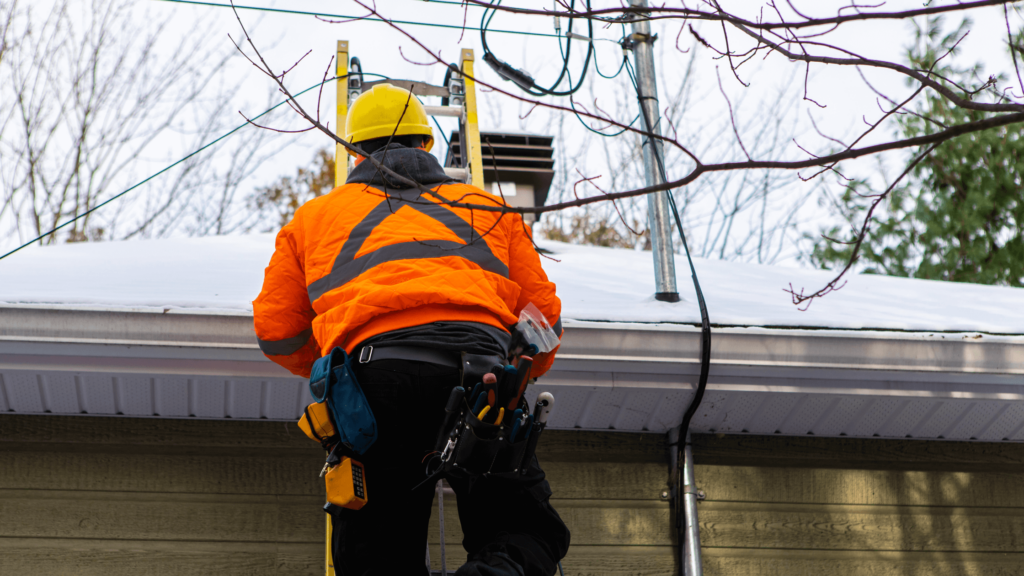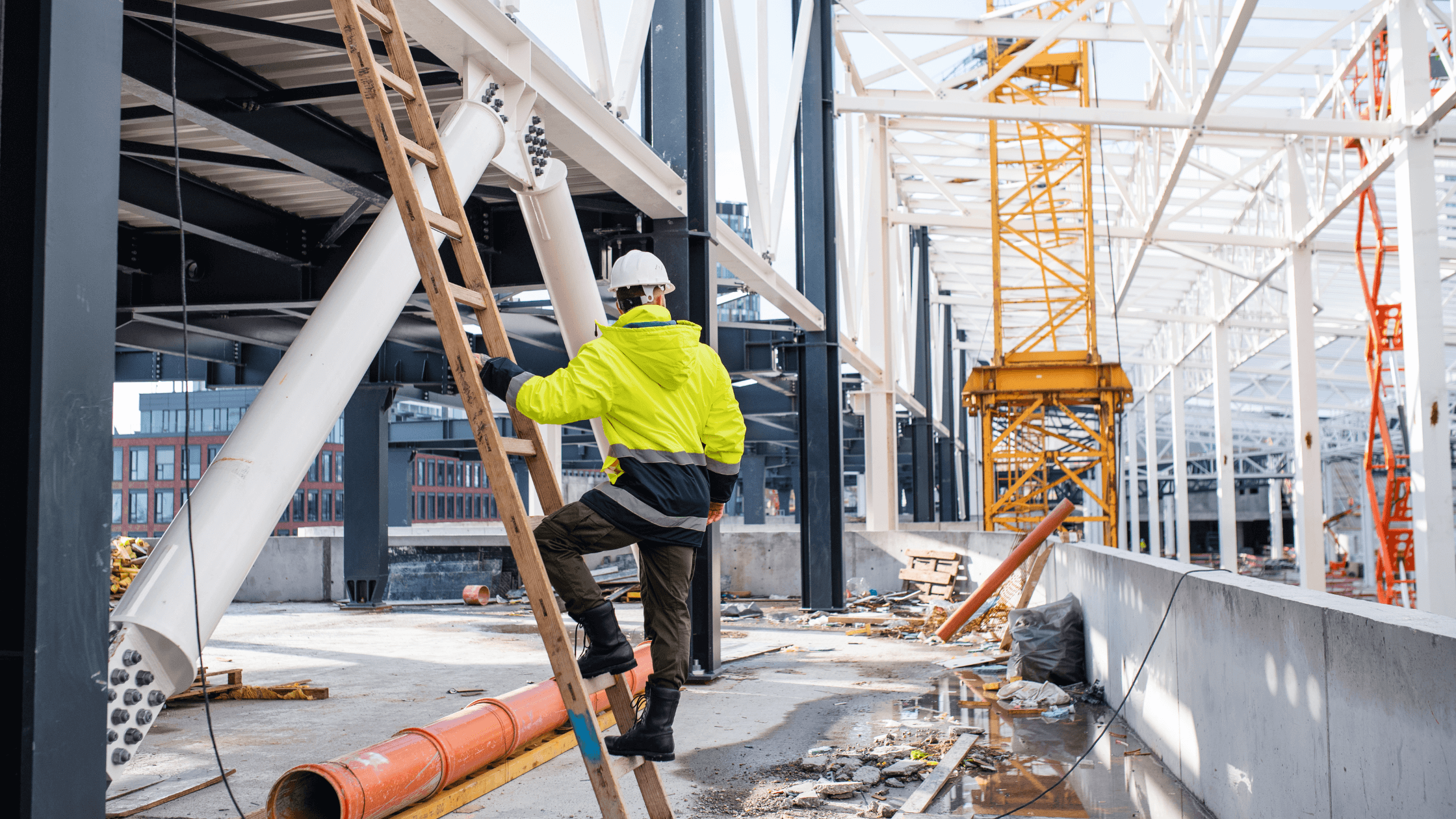Ladders are essential tools in various industries, including construction, engineering, and architecture. However, improper use can lead to serious injuries. In Canada, falls from ladders account for a significant number of workplace accidents each year. To enhance safety, always maintain three points of contact, ensure the ladder is on stable ground, and never overreach while working.
Ladder safety stats
Ladder-related incidents are a significant concern in workplaces across North America. According to the Canadian Centre for Occupational Health and Safety (CCOHS), falls from ladders account for a large percentage of workplace injuries each year, often resulting in serious harm, time off work, or even permanent disabilities. The U.S. Bureau of Labor Statistics reports that in the United States alone, over 20,000 workplace injuries annually involve ladders, with nearly 150 of these resulting in fatalities. The National Institute for Occupational Safety and Health (NIOSH) also notes that ladder-related accidents are among the top causes of workplace injuries and fatalities in construction, making this an issue that demands serious attention.
The financial burden of ladder-related injuries is considerable. A single ladder-related injury can cost employers thousands of dollars in medical expenses, workers’ compensation claims, and lost productivity. For small businesses, these costs can be particularly devastating. A report from the National Institute for Occupational Safety and Health (NIOSH) found that ladder falls lead to an average of $24 billion in medical expenses and work-loss costs annually in the U.S. alone.
Implementing comprehensive ladder safety training and adhering to established safety protocols are essential to mitigating these risks. They reduce accidents, protect workers, and minimize the financial impact on businesses.
8 safety tips for working with ladders

1. Choose the right ladder for the job
Selecting an appropriate ladder is crucial for safety. Consider the task at hand, the required height, and the ladder’s weight capacity. Using a ladder that is too short or not designed for the specific job can lead to instability and accidents. Always check the ladder’s duty rating to ensure it can support your weight and any tools or materials you’ll be using. For instance, a Type I ladder is suitable for heavy-duty use, while a Type III ladder is intended for light-duty tasks.
2. Conduct a pre-use inspection
Before each use, thoroughly inspect the ladder for any signs of damage, such as cracks, bent rungs, or loose components. Ensure that all moving parts operate smoothly and that safety mechanisms, like locks and braces, function correctly. Additionally, check for any slippery substances on the rungs or rails that could cause slips. If any defects are found, remove the ladder from service and have it repaired or replaced.
3. Ladder training
Proper training is essential for safe ladder use. Employees should be educated on correctly selecting the right ladder, setting it up, and recognizing potential hazards. Training should also cover maintaining three points of contact and the importance of not overreaching. Regular refresher courses can help keep safety practices at the forefront of people’s minds and reduce the likelihood of accidents.
4. Climb and descend safely
Always face the ladder when climbing up or down, maintaining three points of contact—either two hands and one foot or two feet and one hand. Avoid carrying tools or materials in your hands; instead, use a tool belt or hoist items up after you’ve reached your working position. Move slowly and deliberately, ensuring each step is secure before proceeding. This cautious approach minimizes the risk of slips and falls.
5. Set up the ladder on a flat and stable surface
Placing the ladder on uneven or unstable ground can lead to tipping. Before setting up, assess the ground conditions and remove debris or obstacles. Use ladder levelers or stabilizers to ensure a firm footing if the surface is soft or inclined. Additionally, avoid setting up ladders in high-traffic areas where they might be bumped or displaced.
6. Avoid overreaching
Overreaching can cause the ladder to become unbalanced and tip over. Always keep your belt buckle (or navel) between the ladder’s side rails. If you need to work beyond your arm’s reach, descend and reposition the ladder closer to your work area. This practice ensures stability and reduces the risk of falls.
7. Do not exceed the ladder’s weight capacity
Every ladder has a maximum weight limit, which includes the user’s body weight plus any tools or materials. Exceeding this limit can cause the ladder to fail. Always check the ladder’s labeling for its weight capacity and ensure it meets the demands of your task. Using a ladder beyond its rated capacity compromises its structural integrity and your safety.
8. Ensure proper ladder angle
For extension or straight ladders, set them up at the correct angle to prevent slipping. A common guideline is the 4-to-1 rule: place the base one foot away from the wall or vertical surface for every four feet of ladder height. This angle provides optimal stability and support during use. Using a ladder at an angle that is too steep or too shallow increases the risk of falls.
Ladder safety DO’S and DON’TS
Proper ladder safety practices are crucial for preventing injuries and ensuring a secure work environment. Here’s a quick guide to the essential do’s and don’ts of using ladders.
DO:
- Inspect the ladder before each use for any damage or defects.
- Ensure the ladder is placed on a stable, level surface.
- Maintain three points of contact while climbing.
- Use a ladder that is the appropriate height for the task.
- Wear non-slip footwear to enhance grip.
- Secure the ladder at the top and bottom if possible.
- Keep your body centered between the side rails.
- Use ladders with non-conductive side rails when working near electricity.
- Ensure locking mechanisms are fully engaged before use.
- Store ladders properly to prevent damage.
DON’T:
- Use a damaged or defective ladder.
- Overreach while working on a ladder.
- Exceed the ladder’s weight limit.
- Place the ladder on slippery or unstable surfaces.
- Use a ladder during adverse weather conditions like high winds or rain.
- Climb a ladder while carrying tools or materials in your hands.
- Use a metal ladder near electrical wires.
- Move or shift a ladder while someone is on it.
- Set up a ladder in a high-traffic area without barriers.
- Use makeshift ladders, such as chairs or boxes.
- Leave a ladder unattended in an unsafe position.
Winter weather amplifies safety hazards

Winter weather introduces unique hazards to ladder safety, particularly in construction and outdoor work. Snow and ice can create slippery surfaces on both the ladder and the ground, increasing the likelihood of slips and falls. Additionally, cold weather can cause materials, such as aluminum or fiberglass, to become brittle, reducing the structural integrity of ladders. Reduced daylight hours during winter also contribute to visibility issues, making it harder to detect potential hazards like icy patches or uneven ground. These conditions make ladder use far riskier, necessitating extra precautions.
Employers and workers should take proactive steps to minimize risks when using ladders in winter weather. Ensure all ladder surfaces are free from snow, ice, and moisture before use, and place ladders on stable, cleared ground. Anti-slip ladder mats or stabilizers can add an extra layer of protection. Workers should wear insulated, slip-resistant footwear for added grip and warmth. Employers should also consider rescheduling non-urgent ladder tasks during severe weather or daylight hours to improve safety. Finally, providing workers with additional training on winter-specific ladder safety can go a long way in reducing accidents.
Bottom line
Ladder safety should be a top priority in any workplace, especially for those in construction, engineering, and architecture. Proper training, thorough inspections, and adherence to safety guidelines can prevent serious injuries and even save lives. Whether choosing the right ladder, following safety protocols, or preparing for winter conditions, a proactive approach makes all the difference.
For more workplace safety tips and insights, subscribe to our newsletter at Under the Hard Hat and follow us on social media. Stay informed, stay safe, and help create safer job sites for everyone.



1 comment